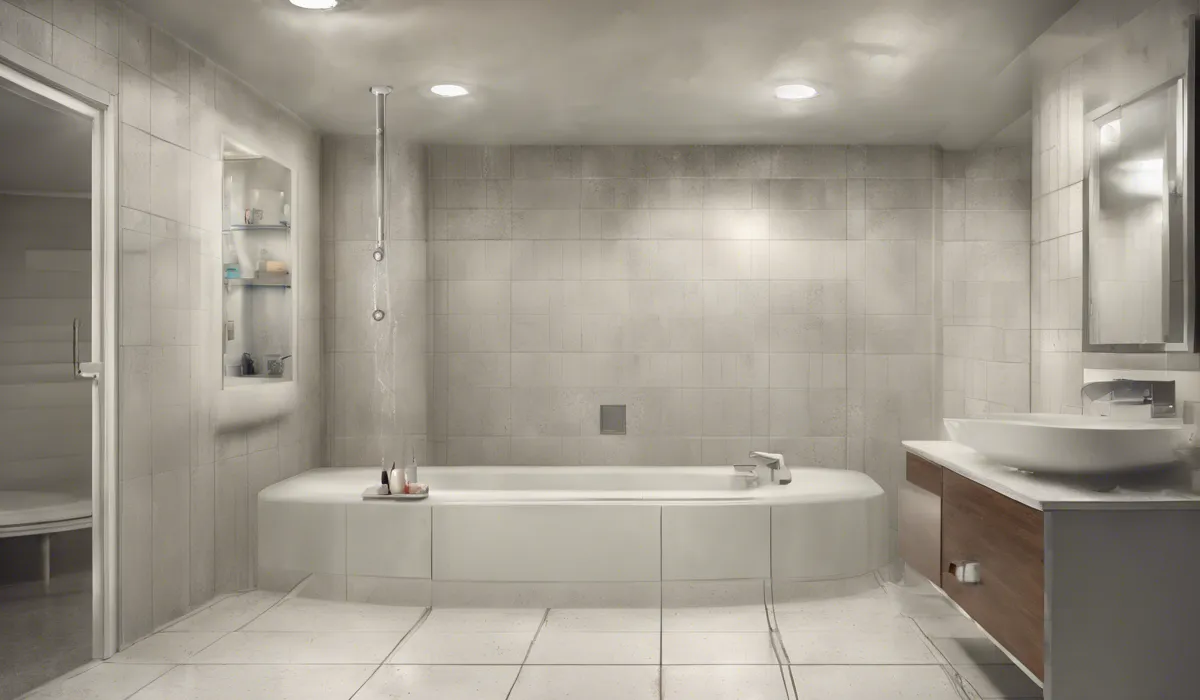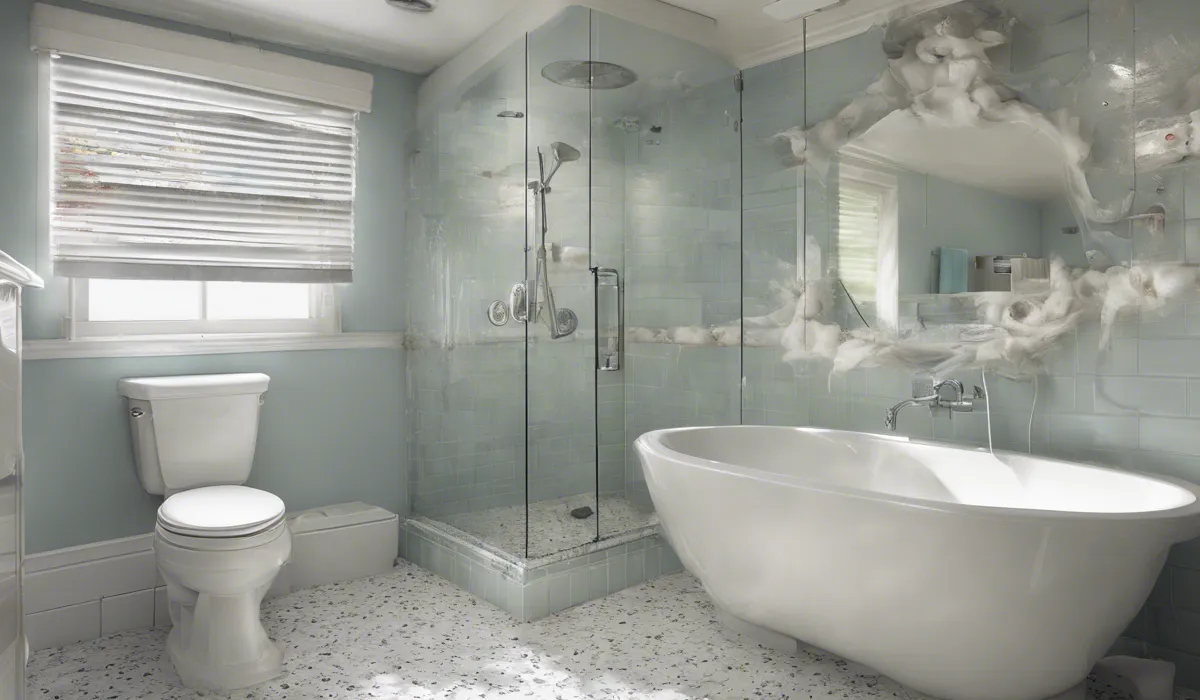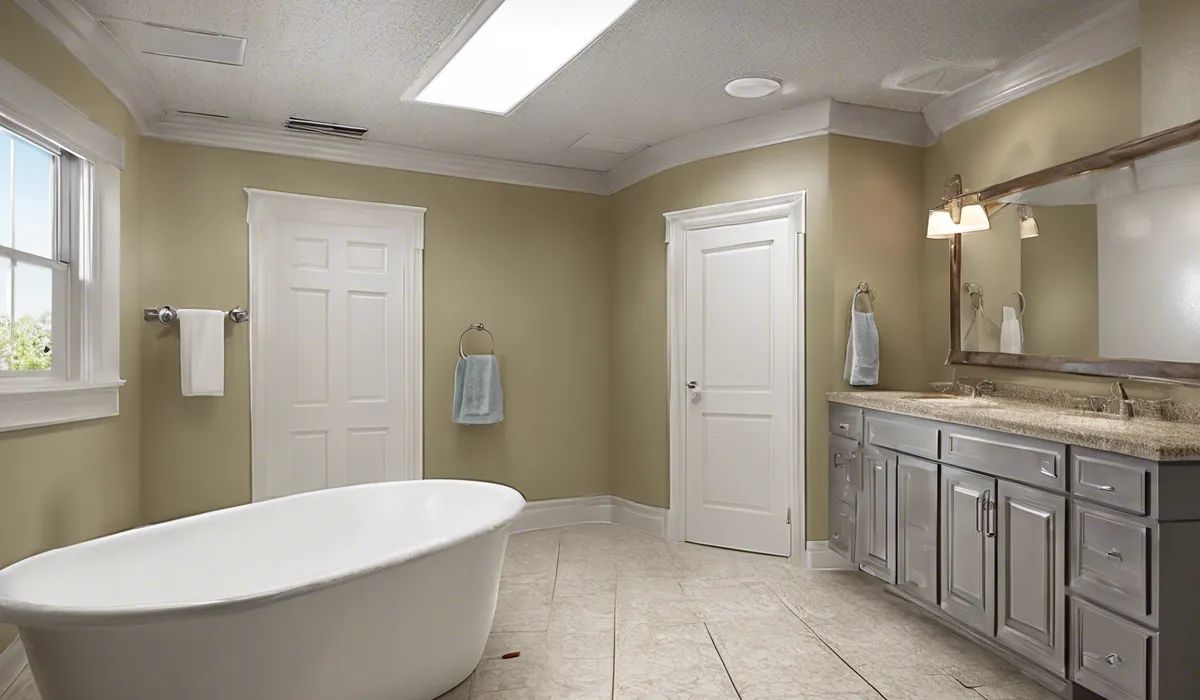To remove mildew from a bathroom ceiling, mix equal parts water and white vinegar, apply to the area with a sponge, let sit for a few minutes, then scrub gently and rinse. Ensure the room is well-ventilated during cleaning.
Identification and Preparation

Recognizing Mildew on Bathroom Ceilings
Mildew often appears as a cluster of small, black or grey spots. It thrives in damp environments like your bathroom ceiling, especially in corners or areas with poor ventilation.
To identify mildew, look for patches or dots that stand out against the ceiling’s surface. These spots might grow larger or become more numerous over time.
Consequences of Ignoring Mildew
Leaving mildew untreated can lead to health issues such as allergies, respiratory problems, and headaches.
Additionally, it can cause the paint and plaster on your ceiling to deteriorate, leading to structural damage. It’s crucial to address mildew quickly to protect both your health and your home.
Essential Safety Measures
Before you begin cleaning, equip yourself with protective gear. Wear gloves to protect your hands from harsh cleaning agents.
A mask will help you avoid inhaling spores or fumes, and goggles will keep your eyes safe. Safety is paramount when dealing with mildew.
Ensuring Proper Ventilation
Open windows or use a fan to keep the air moving in your bathroom. Proper ventilation is essential during the cleaning process to disperse fumes from cleaning solutions and to help dry the ceiling after treatment.
Gathering Cleaning Supplies
Your cleaning toolkit should include a mildew remover or a homemade solution of bleach or vinegar mixed with water.
You’ll also need a spray bottle for application, a sponge or brush for scrubbing, a ladder to reach the ceiling, and protective gear. Ensure all these items are ready before you begin.
The Cleaning Process

Preparing the Cleaning Solution
Mix equal parts of water and white vinegar to create an effective mildew-killing solution. If you choose to use bleach, dilute one part bleach in three parts water.
Always handle bleach with care and never mix it with other cleaning agents.
Application Method
Transfer your cleaning solution into a spray bottle for easy application. Spray generously onto the mildewed areas of your bathroom ceiling or apply the solution with a sponge, ensuring full coverage.
Waiting Period
After application, let the solution sit for a few minutes to penetrate and weaken the mildew’s hold on your ceiling.
This waiting period is crucial for the solution to work effectively.
Scrubbing Technique
With a sponge or brush, gently scrub the affected areas in a circular motion. Be thorough but not too forceful to avoid damaging the ceiling’s surface.
Rinsing the Area
Once you’ve scrubbed away the mildew, rinse the area with clean water. This will remove any remaining cleaning solution and loosened mildew. Ensure that you clear away all residues.
Tips for Stubborn Mildew
If mildew persists, reapply the cleaning solution and let it sit for a longer period. For tough spots, a paste of baking soda and water can be applied before scrubbing.
Drying the Ceiling
After rinsing, it’s essential to dry the area completely. Use a towel or squeegee and keep the ventilation on to air dry the ceiling. A dry environment prevents mildew from returning.
Prevention and Maintenance

Adopting Daily Habits
To minimize humidity, use exhaust fans during and after showers, open windows when possible, and regularly wipe down wet surfaces.
These simple practices will significantly reduce the likelihood of mildew growth.
Establishing Regular Cleaning Routines
Clean your bathroom weekly with a mildew-inhibiting solution. Regular cleaning can prevent mildew from gaining a foothold and will keep your bathroom fresh and sanitary.
Choosing the Right Paint
When repainting your bathroom, opt for mildew-resistant paint. These paints are formulated to withstand high-moisture environments and will help protect your ceiling from mildew.
Implementing Long-term Solutions
Consider installing an exhaust fan if your bathroom lacks one, or upgrade to a more powerful model.
Dehumidifiers can also reduce moisture levels. For a more comprehensive approach, improve your bathroom’s insulation to maintain a more consistent temperature.
Monitoring for Early Signs of Mildew
Regularly inspect your bathroom ceiling for the first signs of mildew. Early detection and treatment will make cleaning easier and help avoid the health risks and structural damage associated with unchecked growth.
FAQs About Removing Mildew from Bathroom Ceiling
What is the best natural solution for removing mildew from a bathroom ceiling?
A natural solution for removing mildew is a mixture of equal parts water and white vinegar, applied with a sponge.
How long should the vinegar solution sit on the mildew before scrubbing?
Let the vinegar solution sit on the mildew for a few minutes before scrubbing.
Should I rinse the ceiling after scrubbing off the mildew?
Yes, after scrubbing gently, you should rinse the area with clean water.
What precautions should be taken when cleaning mildew off a bathroom ceiling?
Ensure the room is well-ventilated during the cleaning process to avoid inhaling fumes or spores.
Can I use a sponge to apply the vinegar solution to the mildew?
Yes, a sponge is an appropriate tool to apply the vinegar solution to the affected area.
Final Thoughts
To tackle mildew on bathroom ceilings, a homemade solution of equal parts water and white vinegar is effective.
Apply it with a sponge, wait a few minutes, then gently scrub and rinse. For safety and effectiveness, ensure the bathroom is well-ventilated throughout the cleaning process.
